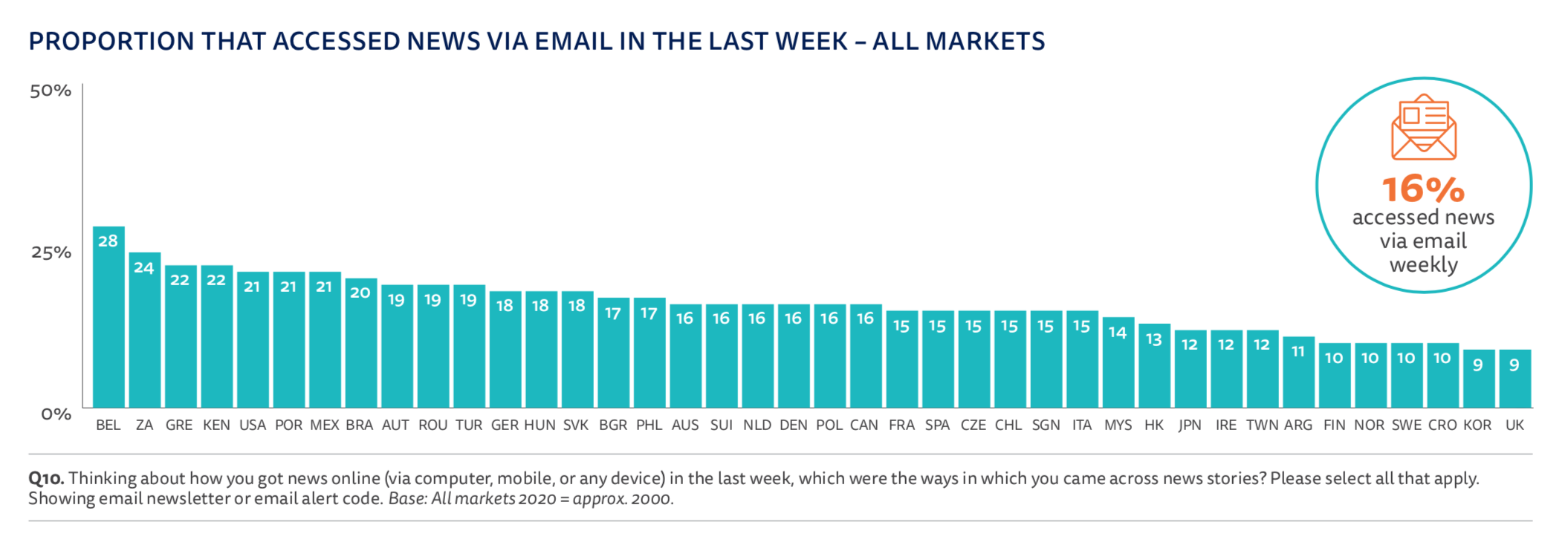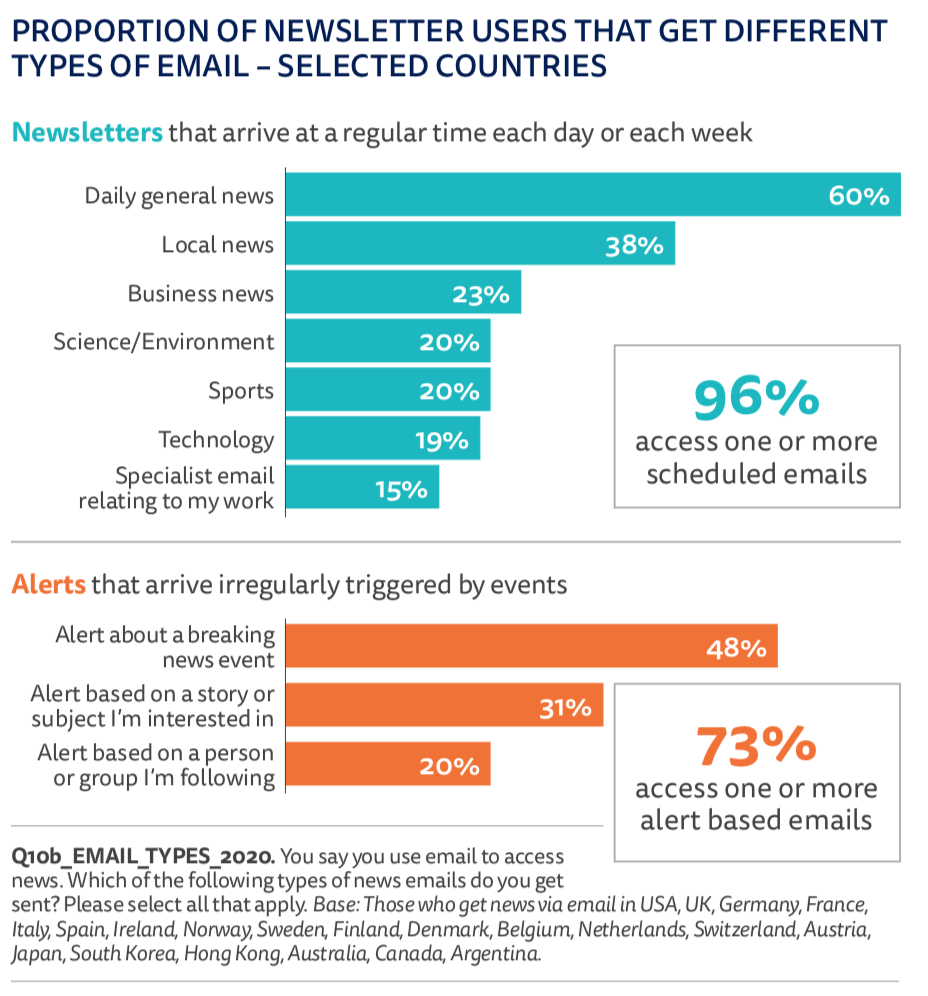
That’s why publishers have already been rethinking their digital proposition with a greater focus on distinctive content that engages users at a deeper level. This shift to habit and loyalty will be important whether the underlying business model is premium advertising or paid content like subscription or membership. This year’s Digital News Report highlights the benefit of two editorially curated products — podcasts and email newsletters — that are likely to become even more important as part of the drive toward habitual digital use.
Despite the simplicity and relative lack of sophistication, our data show that email news is striking a chord with many users, particularly those who are older and more interested in news. Across 40 markets, around one in six (16%) receive news via email each week, 21% in the United States. But we also find that around half of these say email is their main way of accessing news.
Daily update emails, normally sent in the morning, have become an important reminder of the range and diversity of the output of the newsroom and an opportunity to build connection. News organizations such as The New York Times and The Washington Post each offer almost 70 different scheduled emails showcasing the work of different parts of the newsroom, including business, technology, culture, and sports. Over the last few months many have also developed “pop-up” newsletters to showcase coverage on an ongoing story like coronavirus or the 2020 US presidential election. Of those who use email, our data show that 60% get a daily update about general news or politics. Americans get, on average, more emails from different news providers (4) compared with Australians (3) or British (3). Across countries almost half (44%) say they read most of their news emails.

With publishers increasingly wary of platforms, email traffic has been an increasingly important route to content. But with a greater focus on paid models, they are also one of the most effective ways of identifying and converting new digital subscribers.
Once just a series of automated links, the most successful emails are now treated as an editorial product hosted by a senior journalist who brings an informal tone and personal touch which has often been lacking in digital media. The New York Times recently appointed David Leonhardt as anchor of The Morning Newsletter, which it also revealed has more than 17 million subscribers — one of the largest daily audiences of any kind in journalism, across television, radio, print and digital. The use of the term “anchor,” a term borrowed from network TV, shows the value now placed on human curation; on guiding audiences through the news of the day.In the UK Matt Chorley played a similar role for six years as host of the popular Red Box update for The Times newspaper — mixing politics, humor, and various types of user interaction. Chorley has used the email as a springboard to build a wider personal brand with a weekly podcast, and a nationwide stand-up comedy tour. Now he’s giving up the newsletter to take up a new role as a host on the recently launched Times Radio.
The value of editorial curation is a key factor in the success of daily news podcasts such as The Daily from the New York Times and Today in Focus from the Guardian. Hosts like Michael Barbaro and Anushka Asthana play a critical role in setting the tone and building habit.
As our previous research shows, podcasts can also deliver much deeper engagement with people typically listening for up to 30 minutes two or three times each week. Podcast users in the United States say that the format gives greater depth and understanding of complex issues (59%) and a wider range of perspectives (57%) than other types of media. During the coronavirus crisis, we’ve also seen some breakout hits for podcasts that went into significant detail and were hosted or featured experts. One of the most successful has been CNN’s Fact vs. Fiction, where chief medical correspondent Dr. Sanjay Gupta interviews experts on issues like the race for a vaccine. Das Coronavirus-Update is a 30-minute show featuring one of Germany’s top virologists, which reached No. 1 in the podcast charts there.
Podcasts are interesting for publishers because they are much more likely to attract younger audiences, since they can be accessed conveniently through smartphones and they offer a diversity of perspectives and voices.
The deep connection that many podcasts seem to create could be opening up opportunities for paid podcasts, alongside public-service and advertising-driven models. In our data this year we find that almost four in ten Australians (39%) said they would be prepared to pay for podcasts they liked, 38% in the United States, and a similar number in Canada (37%).
Neither email newsletters nor podcasts are going to be the savior of journalism, but they do offer ways in which publishers can build direct connections and ongoing relationships with digital audiences. While a website home page can often be overwhelming and clinical, the hosts and anchors of these products can help guide people through an increasingly complex world, showcasing the full range of talent in a newsroom in the process. Editorial curators are no longer junior staffers but increasingly important public ambassadors for brands shaping the news agenda every day.
But podcasts and emails may only be the start. Curated editions can take many forms, including multimedia packages of content on third-party networks aimed at different market segments. Editorial vs. algorithmic curation could be the next battleground — a chance to show the extra value that publishers can provide and, in the process, help drive more sustainable revenues.
Nic Newman is senior research associate at Oxford University’s Reuters Institute for the Study of Journalism.